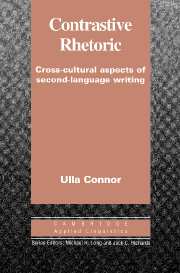Book contents
- Frontmatter
- Contents
- Series editors' preface
- Preface
- I PRELIMINARIES; EARLY PHASES OF THE FIELD
- 1 Toward an extended definition of contrastive rhetoric
- 2 Contrastive rhetoric studies in applied linguistics
- 3 Historical evolution of contrastive rhetoric: from Kaplan's 1966 study to diversification in languages, genres, and authors
- II INTERFACES WITH OTHER DISCIPLINES
- III IMPLICATIONS OF CONTRASTIVE RHETORIC
- References
- Author index
- Subject index
1 - Toward an extended definition of contrastive rhetoric
Published online by Cambridge University Press: 05 October 2012
- Frontmatter
- Contents
- Series editors' preface
- Preface
- I PRELIMINARIES; EARLY PHASES OF THE FIELD
- 1 Toward an extended definition of contrastive rhetoric
- 2 Contrastive rhetoric studies in applied linguistics
- 3 Historical evolution of contrastive rhetoric: from Kaplan's 1966 study to diversification in languages, genres, and authors
- II INTERFACES WITH OTHER DISCIPLINES
- III IMPLICATIONS OF CONTRASTIVE RHETORIC
- References
- Author index
- Subject index
Summary
Writing in a second language: anecdotal evidence about problems and solutions
English as a second language (ESL) students often mention that when they write in English as a second language they translate, or attempt to translate, first language words, phrases, and organization into English. A Chinese ESL student describes his writing process as follows:
While choosing Chinese words is a second nature for me, extracting the proper English word is much more difficult. In casual communication, my inner thoughts are like free river flowing directly from my mind to the paper. I can write whatever appears in my mind. When I write compositions, I come into trouble. There are many good sources I could get from the Chinese culture while I write in Chinese: such as literary quotations, famous old stones, and ancient word of wisdom. These rich sources definitely influence my paper quality in Chinese. Unfortunately examples like this are very hard to translate to English. Sometime I try to make a joke, but it loses its impact in translation. Finding the right English word to match what I am thinking in Chinese is very frustrating and often blocks my writing process. To continue my writing, I have two choices generally. One is to give up this sentence and try to express the same meaning in another way. The other alternative is to check a Chinese-English dictionary. However, translating like that usually leaves me with vague meanings and the impact is lost in the tattered pages of my dictionary. Writing like this is very choppy and does not flow.
- Type
- Chapter
- Information
- Contrastive RhetoricCross-Cultural Aspects of Second Language Writing, pp. 3 - 11Publisher: Cambridge University PressPrint publication year: 1996



